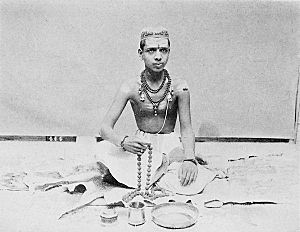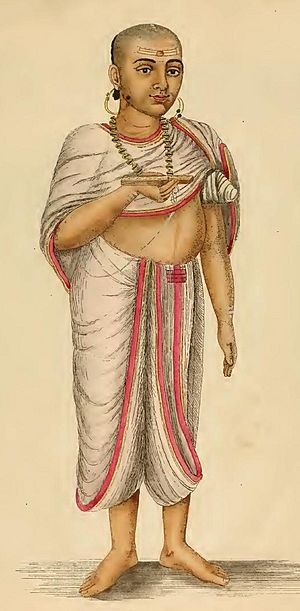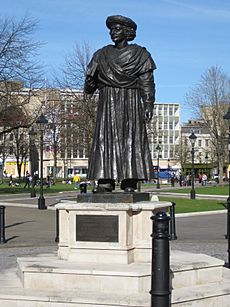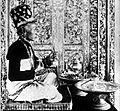Brahmin facts for kids
A Brahmin is a group of people who are part of the caste system in Hinduism. Historically, Brahmins were seen as the highest and most respected group. In ancient India, Brahmins were often teachers, doctors, scholars, or religious people. They were also called Dwij, which means "twice-born," because they helped guide others to learn and grow.
Both Buddhist and Hindu writings say that being a "Brahmin" wasn't just about your family. It was also about being a good and honest person.
There are many smaller groups within Brahmins, depending on where they lived. Some main groups include Rishiswar, Sanadhya, Kanyakubj, Telang, Saryupareen, Bhumihar, Goswami, Tyagi, and Saraswati.
Contents
Understanding the Caste System
The caste system in India grouped people based on their jobs. Brahmins were often the most respected group, especially as priests and teachers. However, some historical records show that Brahmins also worked as farmers, craftspeople, carpenters, and architects.
Later records from the middle of the first thousand years CE show that Brahmins were also farmers and warriors in medieval India. Sometimes, Brahmins were even merchants who traded things like horses, elephants, and pearls across India before the 14th century.
Brahmins' Important Roles
Old Indian texts describe the duties and roles of Brahmins. They were expected to be wise and good people. They had six main duties from the ancient Vedic texts, while others had three. Brahmins often performed religious ceremonies, like weddings, using special hymns and prayers. Most Brahmins also followed a vegetarian diet.
| Adhyayan (Study Vedas) |
Yajana (Perform sacrifices for oneself) |
Dana (Give Gifts) |
Adyapana (Teach Vedas) |
Yaajana (Act as a Priest for sacrifices) |
Pratigraha (Accept Gifts) | |
|---|---|---|---|---|---|---|
| Brahmin | ✓ | ✓ | ✓ | ✓ | ✓ | ✓ |
| Kshatriya | ✓ | ✓ | ✓ | No | No | No |
| Vaishya | ✓ | ✓ | ✓ | No | No | No |
A Look Back: Brahmin History
Brahmins were not often mentioned in Indian texts between 300 BCE and the late 1st century CE. This doesn't mean they didn't exist. It's likely that their culture was mostly in smaller towns and villages, so it wasn't written down much.
During the Gupta Empire, Brahmins became more important. Their role as priests and keepers of sacred knowledge, especially for Vedic rituals, grew significantly.
Famous Brahmins Through History
Chanakya, born in 375 BCE, was a very smart ancient Indian person. He was a teacher, writer, planner, philosopher, and royal advisor. He helped the first Mauryan emperor, Chandragupta Maurya, rise to power and played a big part in starting the Maurya Empire.
Many important thinkers and early leaders of the Bhakti movement were Brahmins. This includes Ramanuja, Nimbarka, Vallabha, and Madhvacharya from Vaishnavism, and Ramananda, who was also a devotional poet.
Ramananda, born into a Brahmin family, welcomed everyone to learn about spirituality. He didn't care about a person's gender, class, caste, or religion (even Muslims). He wrote his spiritual messages in poems using common languages, not just Sanskrit, so more people could understand them. He is known as the founder of the Hindu Ramanandi Sampradaya, which is the largest group of monks in Asia today.
Other important Brahmins from the medieval period include Andal (a female poet from the 9th century), Basava (12th-century Lingayatism), Dnyaneshwar (a Bhakti poet from the 13th century), Vallabha Acharya (a Vaishnava poet from the 16th century), and Chaitanya Mahaprabhu (a Vaishnava saint from the 14th century).
Images for kids
-
Adi Shankara, who helped unite and establish the main ideas in Hinduism, was born in a Brahmin family.
-
Among the Hindus of Bali, Indonesia, Brahmins are called Pedandas. The role of Brahmin priests, called Sulinggih, has been open to both genders since medieval times. A Hindu Brahmin priestess is shown above.
See also
 In Spanish: Brahmán (casta) para niños
In Spanish: Brahmán (casta) para niños









